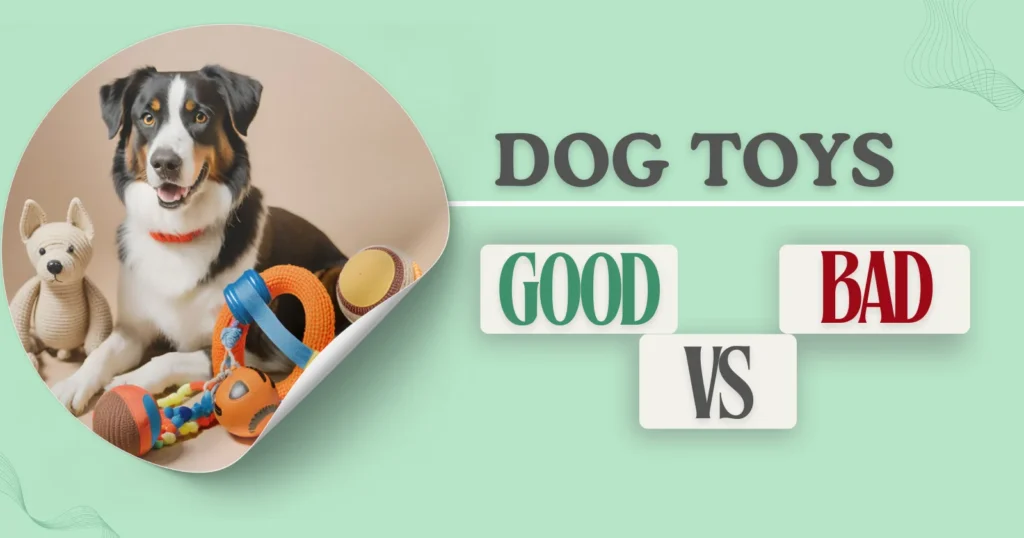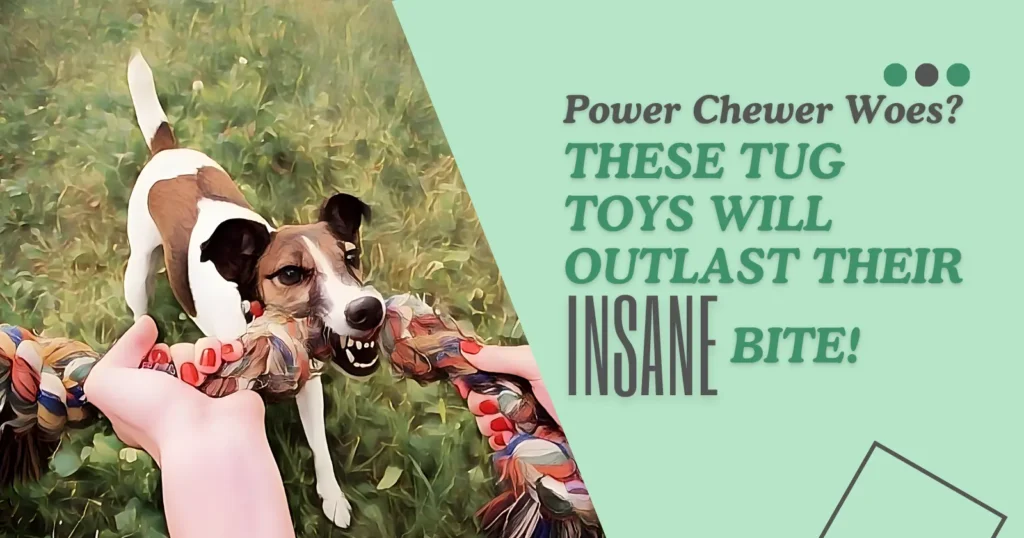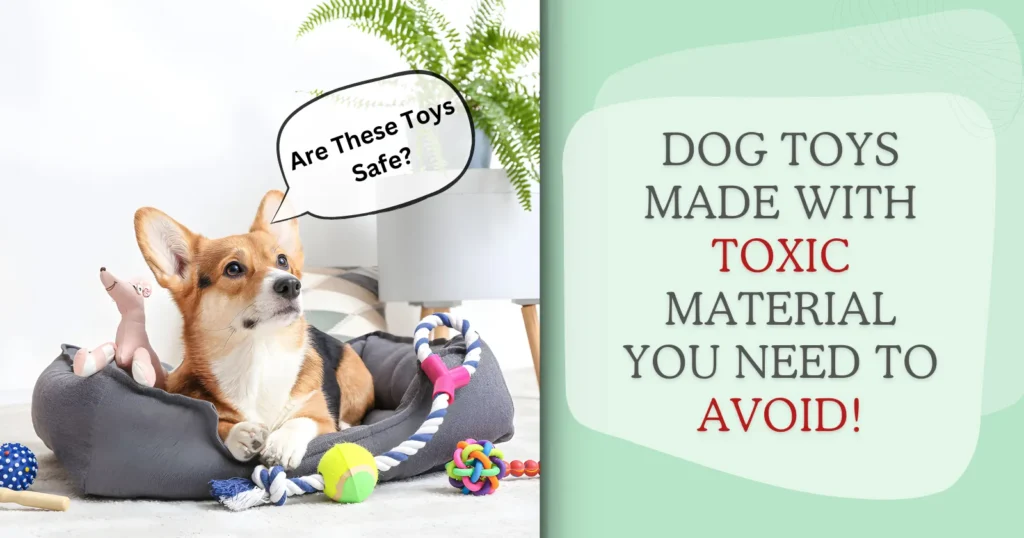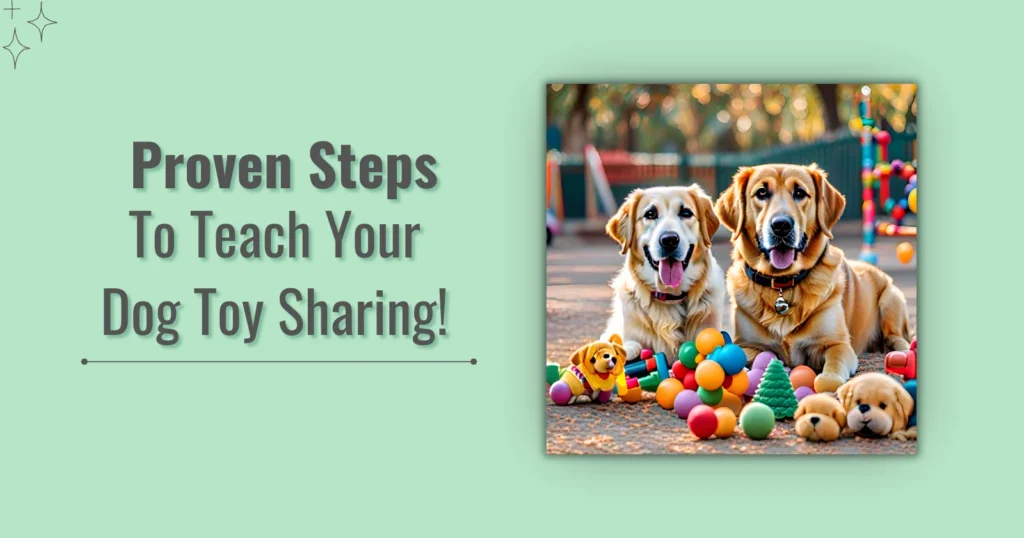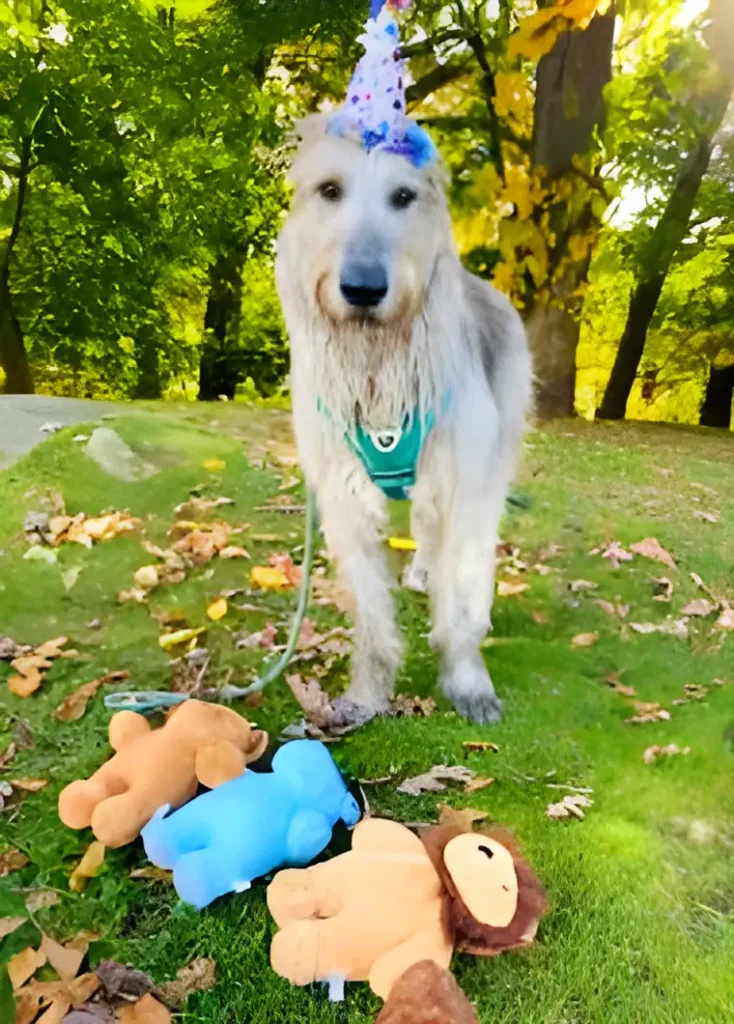

Choosing a toy for your dog can be a pretty complicated task if you can’t tell what’s good vs what’s bad for your furry friends. Not all toys are created equal, and choosing the wrong type can lead to more than just disappointment; it can be downright dangerous. In this detailed guide, I’ll walk you through the various kinds of dog toys available on the market and help you discern between the good and the bad. By the end of this article, you’ll be well-equipped to select toys that are not only fun but safe and suitable for your furry friend.
Assessing 8 Different Types of Dog Toys: Good vs. Bad Traits
1. Rope Dog Toys
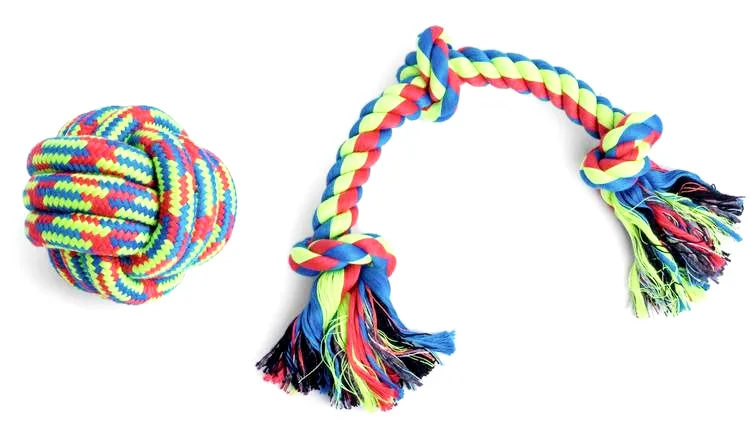

Good:
Rope toys are fantastic for mental stimulation and particularly enjoyable for dogs that love to play tug-of-war. They’re also excellent for dental health, as the fibers help clean teeth by removing plaque as the dog chews. Quality rope toys are generally safe and durable and provide hours of fun and exercise. Cotton rope toys that are colored with non-toxic dyes are safe for your pooch to play with.
They help to alleviate boredom, reduce destructive behavior, and strengthen jaw muscles.
Bad:
Cheaply made rope toys can be hazardous. They might unravel quickly and, if swallowed, can lead to gastrointestinal blockages. Always opt for ropes that are tightly woven and made from natural fibers. Avoid any rope toy that starts fraying too quickly, particularly cotton rope toys made from a blend of polyester or acrylic fibers can be hazardous to your dog’s health.
Vets have also warned against giving rope toys to dogs. They have often expressed concern with rope toys, that the strands of rope or string may be ingested and act as a linear foreign body in your dog’s gastrointestinal tract.
Often, when you let your dog chew on toys unsupervised they can end up swallowing strands they pull out from these toys. In some cases, the danger may increase up to the point where they end up needing surgery; it can lead to a dangerous digestive obstruction that requires surgery and can be fatal.
Personally, my dog absolutely loves his rope toy. It’s held up well against his vigorous play as it is high quality, but I always make sure to inspect it for signs of wear and tear after each play session.
2. Rubber Dog Toys


Rubber and TPR (Thermoplastic Rubber):
While not fabrics, rubber and TPR are popular materials in dog toys due to their durability, flexibility, and resistance to heavy chewing.
Good:
High-quality rubber toys, like those made by reputable brands such as KONG, are ideal for chewers. They’re durable, often come in various sizes and hardness levels, and can be stuffed with treats to provide extra mental stimulation. Rubber toys are a safe, non-toxic option for dog toy material. The material is durable yet pliable enough not to cause damage to your pet’s teeth. When buying, look to test the durability of your dog’s toys and do the thumbnail test. If your thumbnail can make an indent in the object, it’s okay to chew.
“Soft, rubber toys are great options for puppies that are teething or biting” – Dr. McCullough says. However, you should always ask your veterinarian first and be sure to monitor your puppy as well as older dogs when they’re playing with a toy.
Bad:
Low-quality rubber toys may contain harmful chemicals or break apart easily, posing a choking hazard. Always check the labels for non-toxic materials and read reviews before purchasing. They carry an additional risk of being made with harmful toxic materials and additives such as bisphenol A – also known as BPA; therefore, look for products made with natural rubber. Avoid rubber plastics at all costs, as they will result in choking hazards or gastrointestinal obstruction.
I find that filling a rubber KONG with peanut butter and freezing it makes for a great summer treat that keeps my dogs entertained and relaxed.
3. Shein Dog Toys
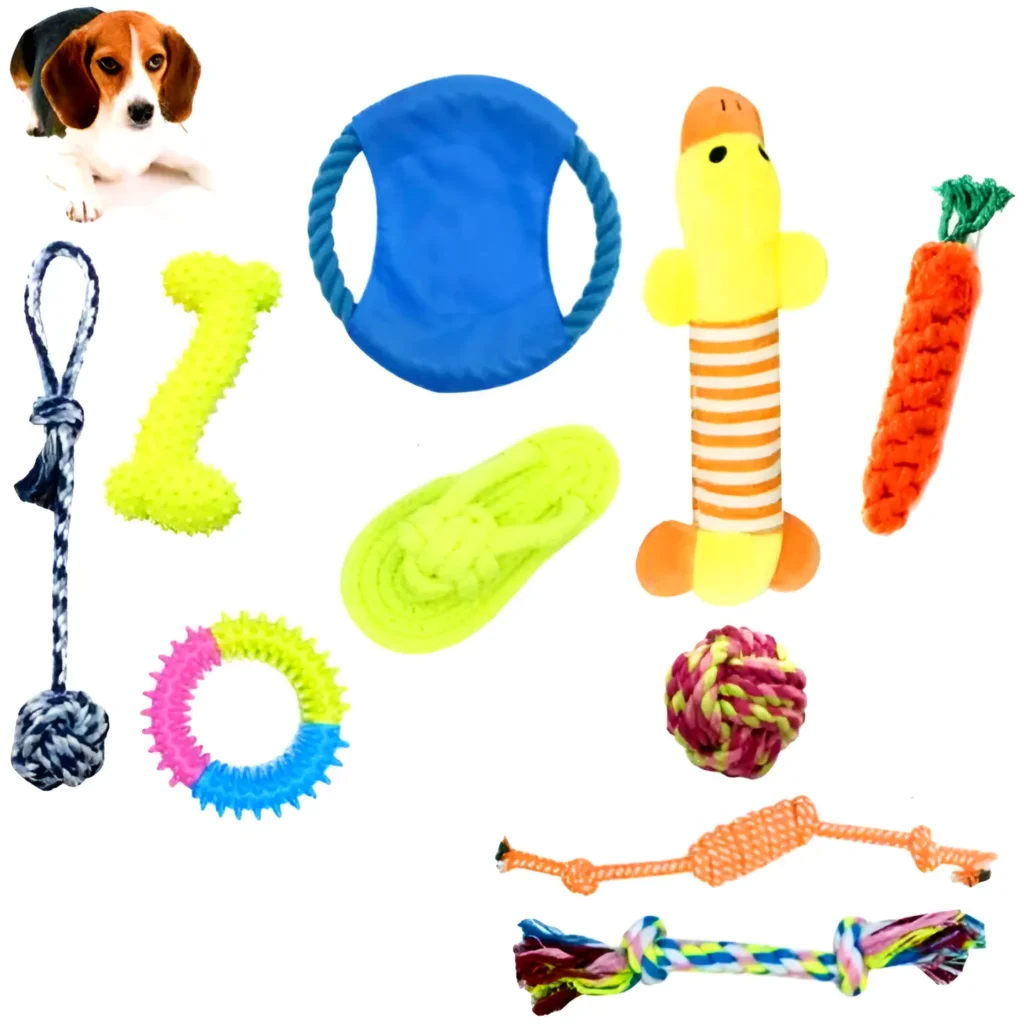

Good:
Shein, primarily known for fast fashion, also offers a range of affordable dog toys. These can be good for casual chewers or for variety in your dog’s toy box. They come in various shapes, sizes, and colors that are viable for mental stimulation for our furry friends.
Bad:
There’s often little information about the materials used in these toys, which can be a red flag. The durability and safety of Shein dog toys may not be up to the standards required for intense chewers or larger breeds. There has been speculation about the glue used for keeping these toys being questionable; hence should be avoided.
I usually see that Shein toys are easily breakable because they are either glued or taped together; others are just not sturdy enough to withstand play, which is why they aren’t safe.
Note: Always supervise your dog with new toys, especially from brands that aren’t pet-specialized, to see how the toy holds up.
4. Hard Chew Toys


Good:
Hard chew toys made from nylon or tough rubber can endure the jaws of aggressive chewers and last a long time. These toys can help satisfy a dog’s natural chewing instinct and prevent them from turning to less desirable objects, like shoes or other household items. Such toys are durable and long-lasting; therefore, these toys are recommended for aggressive chewers, especially of large breeds, who love shredding every toy they can get their hands on. (interlink introducing chew toys without the tear apart and toys for most aggressive chewers0
They are less likely to be swallowed and usually come in one shape with no additional attachments that can be ingested or ripped apart. Last a considerably long time.
Some dogs enjoy the sensation of chewing on harder toys, while others favor items like balls or Frisbee that offer excitement through chasing and retrieving. Meanwhile, there are dogs that show little interest in toys unless their owner is actively involved in the play.
Bad:
If too hard, these toys can cause dental damage, including broken teeth. Make sure the toy isn’t so hard that you can’t make an indent on the surface with your fingernail; otherwise, your dog may end up with a fractured jaw.
Hard plastic and nylon bones are common chew toys, typically crafted from materials tougher than a dog’s teeth, leading to potential fractures during chewing. The teeth most commonly impacted are the upper fourth premolars, which are crucial for breaking down food.
How to check a hard chew toy?
The fingernail test entails checking the chew’s pliability; pressing it lightly with a fingernail should make a dent. The kneecap test involves tapping your knee with the chew; if it causes pain, the toy is tough. In the stress test, the chew should bend or flex slightly when force is applied.
5. Catnip Toys
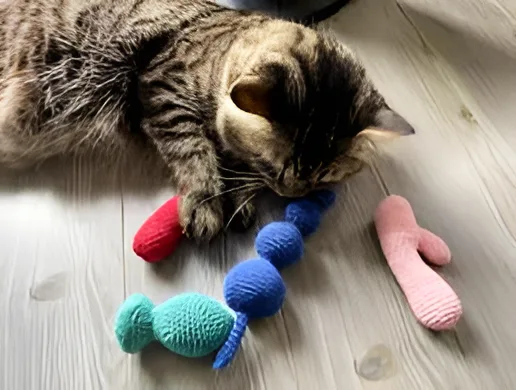

Good:
Catnip can have a calming effect on dogs, unlike its stimulating impact on cats, making it a useful aid for dogs suffering from anxiety or sleep disturbances. While there are many calming products, such as CBD, available for dogs, catnip is a natural alternative that may also help with muscle spasms, diarrhea, and minor respiratory issues, according to “1,001 Old-Time Household Hints.” The herb contains essential nutrients like vitamins C and E, magnesium, flavonoids, tannins, and essential oils, which contribute to its health benefits. However, it’s important to note that not all dogs react to catnip, and for those that do, the effects can be quite different from the response seen in cats.
Animal Wellness magazine explains the effects of catnip on canines in detail.
Bad:
While catnip is non-toxic to dogs, it generally does not appeal to them as it does to cats. Catnip toys are also typically not designed to withstand dog chewing. Including these in a dog’s toy collection is generally a miss, as the soft effect cause can quickly be destroyed or ingested by dogs. They can lead to choking hazards. While a small amount of catnip may be harmless for dogs, toys specifically designed for cats are not suitable for dogs. Cat toys often contain small components, such as squeakers or fillings, that could be accidentally ingested by dogs, especially since these toys are designed for smaller animals. According to Dr. Debra Primovic, DVM, swallowing these small parts can lead to the ingestion of the entire toy, posing a risk of foreign body obstruction—a severe health issue that might require surgical intervention.
Dr. Primovic warns that many cat toys are small, and some dogs have a tendency to chew or “eat” objects, which can lead to gastrointestinal obstructions. To ensure your dog’s safety and health, it’s best to avoid leaving cat toys around your home.
6. Laser Dog Toys
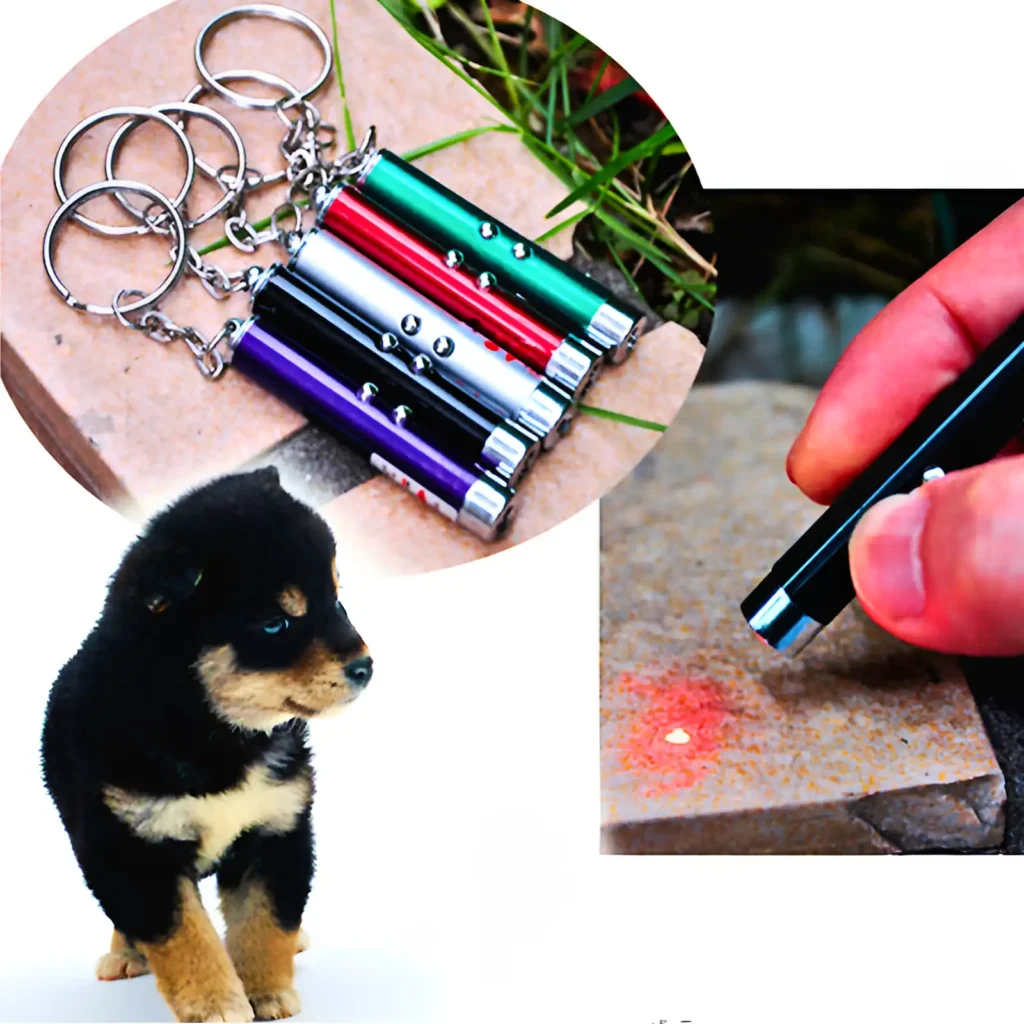

Good:
In moderation, laser toys can provide a fun and engaging way to exercise your dog as they chase the elusive light that entertains them.
Nicholas Dodman, animal behavior expert and professor at Tufts University’s Cummings School of Veterinary Medicine explains that your dog instinctively chases laser beams simply because they move. Movement triggers a dog’s innate prey drive.
Bad:
Overuse can lead to obsessive behaviors or frustration in dogs because they never get the satisfaction of catching their “prey.” It’s important to conclude play with a tangible toy your dog can catch to prevent any fixations or frustrations. Dogs may develop an obsession with light, which can extend to similar stimuli, leading to behavior problems where they chase lights and shadows. While it may seem cute to have them chase a red dot in circles, however, this may even lead to the development of OCD in our furry friends. They might even start attacking light wherever they see it in frustration.
Further, such toys possess a risk of causing blindness and serious eye injuries due to the intense light rays; hence need to be controlled when used.
While my friend’s border collie, Jess, enjoys chasing the laser pointer, he always ends their play sessions with a few throws of her favorite ball to ensure she feels a sense of achievement. He says his dog doesn’t seem to exhibit any compulsive behaviors but why risk it?
7. Plastic Chew Toys


Bad:
These are often not durable enough for most dogs and can break into sharp pieces, risking ingestion and internal damage. Always opt for higher-quality materials. If ingested, it may even get stuck in our furry friends’ guts.
These plastic toys are often made with Polyvinyl Chloride (PVC), also known as vinyl, which is an extremely hard plastic that is too tough for dogs to chew. To make it softer and gentler on a dog’s teeth, phthalates are added to PVC, which also gives it its distinctive smell. The more your dog plays and chews on vinyl, the more phthalates seep out. These toxins move freely and can be absorbed into your dog’s gums or skin. Additionally, PVC contains chlorine. As a dog chews a toy made of PVC, the chlorine is released over time.
However, it’s important to note that phthalates are highly toxic to dogs. They are simply not good and not safe under any circumstances.
NOTE: if you’re ever in a situation where your pet has swallowed plastics or chewed off a piece of their toy, contact a veterinarian as soon as possible.
8. Silicone Dog Toys


Good:
Silicone dog toys are generally softer and more flexible than hard toys. They’re often a good choice for moderate chewers and can come in vibrant colors and interesting designs. They tend to be pliable as well as nontoxic; they are a safe bet for your dog’s teeth and do not cause any damage to them.
In case your dog chews off a piece and swallows it, the material is not digestible therefore will pass as it was swallowed. However, you should contact your veterinarian regardless. Silicone has a very strong smell to it as it is drying, and the fumes could harm your pets. Once it is fully cured and no longer smells, it is completely safe.
Bad:
For strong chewers, silicone may not hold up, and pieces can be chewed off and swallowed. Always monitor your dog’s interaction with silicone toys. Also, something to look out for when buying silicone toys to ensure your dog doesn’t have an allergic reaction to it. To ensure your dog isn’t allergic, do a patch test.
Conclusion
Choosing the right toys for your dog involves understanding their individual needs, chewing habits, and play preferences. Avoiding the “bad” toys and opting for the “good” ones will not only save you money in the long run but also keep your furry friend safe, healthy, and happy. Hard rubber and cotton blend rope toys are typically good for your dog, while plastics, catnip, and silicone toys are typically bad for our furry friends bad for them.
Remember to periodically review your dog’s toys for any signs of damage and replace them when necessary. With the right selection, your dog’s toy box can offer them endless hours of fun and joy.
In conclusion, selecting the right toys for your dog is crucial for their well-being, engagement, and safety. By understanding the specific characteristics that distinguish good toys from bad ones across various categories—from rope and rubber to silicone and laser toys—you can make informed choices that suit your dog’s individual play habits and chewing strength. Remember, the best dog toys are those that are not only fun but also durable and safe, promoting healthy play without risks. Regularly inspect and replace your dog’s toys to ensure they remain safe for enjoyment and continue to provide mental and physical stimulation as your loyal companion grows and evolves.

